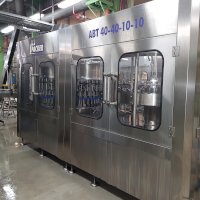Rinsing-filling-capping monoblock
We recommend our rinsing-filling-capping monoblocks for bottling various products with an output of up to 12,000 bottles / hour. These machines are suitable for rinsing, filling and closing many types of bottles (PET bottles, glass bottles, metal cans). The advantage of a monoblock design is that the operation of rinsing, filling and closing can be performed within a single machine, there is no need to have 3 separate machines.
This type of machine is suitable for filling all kinds of carbonated and non-carbonated liquid, be they fluent or dense products. Our rinsing-filling-capping monoblock machines are manufactured for different types of liquids, in designs with different filling methods.
Rinsing the bottles is possible in several ways: with air, clean water or in 2 phases: with chemical and then clean water. Depending on the cap type, the machines can have various closing units or capping heads. PET bottles enter the machine on an air conveyor while glass bottles and metal cans arrive on a conveyor belt.
The machines are available in a monoblock design (rinsing-filling-capping / filling-capping version) or in a seperate version.
Properties:
- Nominal output: up to 12.000 bottles/hour (depending on bottle size and liquid).
- Container: PET bottle, glass bottle, metal can.
- Filling method: counterpressure (isobaric) level, gravity, vacuum, piston, owerflow filling.
- Capping: plastic screw cap (normal, shorty, sport, etc.), metal screw cap, crown cork, cork, twist-off cap, can seamer, etc.
Field of food industry application:
- Carbonated products: mineral water, soft drink, sparkling wine, champagne, beer, etc.
- Non-carbonated products: water, soft drink, wine, alcoholic beverage, juice, tea, syrup, sauce, edible oil, etc.
- Dence liquids: jam, syrup, ketchup, mustard, etc.
Main features:
- All parts in contact with the liquid are made of stainless steel (Wnr. 1.4301) or food grade plastic.
- The construction of the machine ensures the reliable operation.
- Low maintenance requirements.
- The machine equipped with an automatic cap feeder.
- Central lubrication system.
- Touch screen machine control.
- Optional brand pneumatic and electronic components.
Options:
- Suitability for cleaning and disinfection by CIP system,
- tooling for different bottle sizes,
- automatic central lubrication system,
- completing the automatic cap feeder with a cap disinfection unit and cap washer,
- analog and digital fluid and carbon dioxide level control,
- production intensity-dependent speed and line control,
- nitrogen dosing unit,
- hot filling,
- aluminium cover welding.
Features of the main filling methods:
- Counterpressure filler
Counterpressure (isobar) filling machines are systems primarily designed for filling carbonated products, such as mineral waters, soft drinks. The filling process starts as a result of equalizing pressure in the bottle and the product tank. The filling level is determined by the length of the return air pipe. Isobaric filling machines allow multiple phases to be completed, such as pressurization of the bottle, single or pre-vacuuming, carbon dioxide rinsing, filling and decompression. Pre-vacuuming and carbon dioxide rinsing are important for products where there is requirement for a low oxygen uptake during filling. - Gravity filling machine
Gravity filling machines are recommended for filling non-carbonated, low-viscosity materials such as water, wines and spirits. Pressing up the bottle mouth to the filler head airtight starts the filling process. The filling level of the liquid flowing into the bottle by gravity is determined by the length of the return air pipe. These gravity fillers can be adapted for hot filling of juices and teas. - Vacuum filling machine
The vacuum filling machines are mainly used for filling denser, medium viscosity materials, such as edible oils, syrups, sauces. The vacuum created in the bottles starts the filling process, so even dense materials could flow more easily from the liquid tank into the bottles. Excess material above the desired filling level is removed. Containers that are rigid enough to be filled with vacuum can be used. - Piston filling machine
Piston filling (volumetric) machines are mainly suitable for filling high viscosity materials (sauces, syrups, ketchup, mustard, etc.) and dense, fibrous materials (eg. jams). Piston volumetric fillers are machines designed to fill a predetermined volume of liquid, thus guaranteeing the accuracy of the amount of liquid in the bottles. With the help of these machines dense, viscous materials can be filled into non vacuum resistant bottles as well. - Overflow filling machine
Overflow filling machines are recommended for filling non-carbonated, low and medium viscosity liquids (waters, soft drinks, oils, sauces, etc.). Pressing up the bottle mouth to the filler head airtight, starts the filling process. The filling level of the liquid flowing into the bottle by gravity is determined by the length of the return air pipe. Excess material above the desired filling level is removed. These overflow fillers can be adapted for hot filling of juices and teas.














